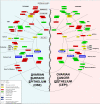Gene expression profiling supports the hypothesis that human ovarian surface epithelia are multipotent and capable of serving as ovarian cancer initiating cells
- PMID: 20040092
- PMCID: PMC2806370
- DOI: 10.1186/1755-8794-2-71
Gene expression profiling supports the hypothesis that human ovarian surface epithelia are multipotent and capable of serving as ovarian cancer initiating cells
Abstract
Background: Accumulating evidence suggests that somatic stem cells undergo mutagenic transformation into cancer initiating cells. The serous subtype of ovarian adenocarcinoma in humans has been hypothesized to arise from at least two possible classes of progenitor cells: the ovarian surface epithelia (OSE) and/or an as yet undefined class of progenitor cells residing in the distal end of the fallopian tube.
Methods: Comparative gene expression profiling analyses were carried out on OSE removed from the surface of normal human ovaries and ovarian cancer epithelial cells (CEPI) isolated by laser capture micro-dissection (LCM) from human serous papillary ovarian adenocarcinomas. The results of the gene expression analyses were randomly confirmed in paraffin embedded tissues from ovarian adenocarcinoma of serous subtype and non-neoplastic ovarian tissues using immunohistochemistry. Differentially expressed genes were analyzed using gene ontology, molecular pathway, and gene set enrichment analysis algorithms.
Results: Consistent with multipotent capacity, genes in pathways previously associated with adult stem cell maintenance are highly expressed in ovarian surface epithelia and are not expressed or expressed at very low levels in serous ovarian adenocarcinoma. Among the over 2000 genes that are significantly differentially expressed, a number of pathways and novel pathway interactions are identified that may contribute to ovarian adenocarcinoma development.
Conclusions: Our results are consistent with the hypothesis that human ovarian surface epithelia are multipotent and capable of serving as the origin of ovarian adenocarcinoma. While our findings do not rule out the possibility that ovarian cancers may also arise from other sources, they are inconsistent with claims that ovarian surface epithelia cannot serve as the origin of ovarian cancer initiating cells.
Figures




Similar articles
-
Molecular and functional characteristics of ovarian surface epithelial cells transformed by KrasG12D and loss of Pten in a mouse model in vivo.Oncogene. 2011 Aug 11;30(32):3522-36. doi: 10.1038/onc.2011.70. Epub 2011 Mar 21. Oncogene. 2011. PMID: 21423204 Free PMC article.
-
The stem-cell profile of ovarian surface epithelium is reproduced in the oviductal fimbriae, with increased stem-cell marker density in distal parts of the fimbriae.Int J Gynecol Pathol. 2013 Sep;32(5):444-53. doi: 10.1097/PGP.0b013e3182800ad5. Int J Gynecol Pathol. 2013. PMID: 23896717
-
Molecular profiling predicts the existence of two functionally distinct classes of ovarian cancer stroma.Biomed Res Int. 2013;2013:846387. doi: 10.1155/2013/846387. Epub 2013 May 9. Biomed Res Int. 2013. PMID: 23762861 Free PMC article.
-
Mechanism for the Decision of Ovarian Surface Epithelial Stem Cells to Undergo Neo-Oogenesis or Ovarian Tumorigenesis.Cell Physiol Biochem. 2018;50(1):214-232. doi: 10.1159/000494001. Epub 2018 Oct 18. Cell Physiol Biochem. 2018. PMID: 30336465 Review.
-
Cancerous ovarian stem cells: obscure targets for therapy but relevant to chemoresistance.J Cell Biochem. 2013 Jan;114(1):21-34. doi: 10.1002/jcb.24317. J Cell Biochem. 2013. PMID: 22887554 Review.
Cited by
-
Screening of feature genes of the ovarian cancer epithelia with DNA microarray.J Ovarian Res. 2013 Jun 5;6(1):39. doi: 10.1186/1757-2215-6-39. J Ovarian Res. 2013. PMID: 23738901 Free PMC article.
-
Article by Natalie Banet and Robert J. Kurman: Two types of ovarian cortical inclusion cysts: proposed origin and possible role in ovarian serous carcinogenesis; Int. J. Gynecol. Pathol. 2015;34:3-8.Int J Gynecol Pathol. 2015 May;34(3):303-4. doi: 10.1097/PGP.0000000000000202. Int J Gynecol Pathol. 2015. PMID: 25844551 Free PMC article. No abstract available.
-
Discovery of differentially expressed proteins for CAR-T therapy of ovarian cancers with a bioinformatics analysis.Aging (Albany NY). 2024 Jul 18;16(14):11409-11433. doi: 10.18632/aging.206024. Epub 2024 Jul 18. Aging (Albany NY). 2024. PMID: 39033780 Free PMC article.
-
Identification of Differentially Expressed Genes (DEGs) Relevant to Prognosis of Ovarian Cancer by Use of Integrated Bioinformatics Analysis and Validation by Immunohistochemistry Assay.Med Sci Monit. 2019 Dec 24;25:9902-9912. doi: 10.12659/MSM.921661. Med Sci Monit. 2019. PMID: 31871312 Free PMC article.
-
Epigenetic Crosstalk between the Tumor Microenvironment and Ovarian Cancer Cells: A Therapeutic Road Less Traveled.Cancers (Basel). 2018 Aug 30;10(9):295. doi: 10.3390/cancers10090295. Cancers (Basel). 2018. PMID: 30200265 Free PMC article. Review.
References
-
- A Snapshot of Ovarian Cancer. http://planning.cancer.gov/disease/Ovarian-Snapshot.pdf
-
- Cancer Facts and Figures 2009. http://www.cancer.org/downloads/STT/500809web.pdf
-
- Scully RE, Clement PB, Young RH. In: STERNBERG'S Diagnostic Surgical Pathology. Mills SE, editor. Philadelphia, PA: Lippincott Williams & Wilkins; 2004. Ovarian Surface Epithelial-Stromal Tumors; pp. 2543–2578.
Publication types
MeSH terms
LinkOut - more resources
Full Text Sources
Other Literature Sources
Medical
Molecular Biology Databases

